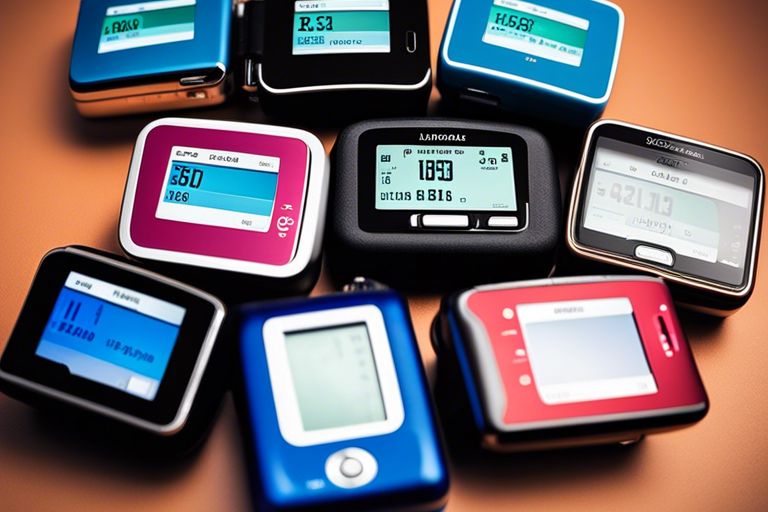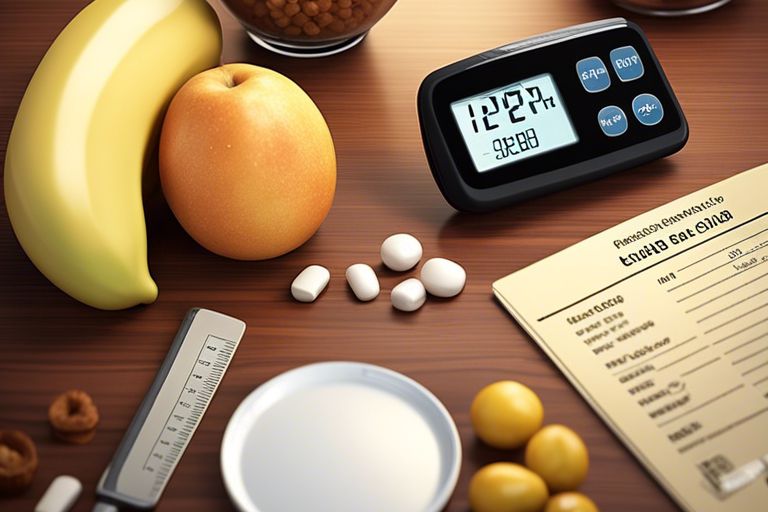Embarking on the journey of managing Type 1 Diabetes can seem daunting, but with the right tools and knowledge, it can be navigated with confidence and success. By implementing practical strategies and understanding the nuances of this chronic condition, individuals can effectively manage their blood sugar levels and lead a fulfilling life. In this comprehensive guide, we will explore into essential tips and techniques to empower and support those living with Type 1 Diabetes in taking control of their health and well-being.
Key Takeaways:
- Regular Monitoring: It is crucial for individuals with Type 1 Diabetes to regularly monitor their blood sugar levels to manage their condition effectively.
- Insulin Therapy: Proper insulin therapy, whether through injections or an insulin pump, is essential to control blood sugar levels in Type 1 Diabetes.
- Healthy Lifestyle: Maintaining a balanced diet, engaging in regular physical activity, and managing stress are key factors in managing Type 1 Diabetes successfully.
- Continuous Education: Ongoing education about the condition, including understanding nutrition labels and counting carbohydrates, can empower individuals with Type 1 Diabetes to make informed choices.
- Medical Team Collaboration: Working closely with healthcare providers, including endocrinologists, dietitians, and diabetes educators, ensures comprehensive care and support for managing Type 1 Diabetes.
Daily Management Strategies
Monitoring Blood Sugar Levels
The key to managing type 1 diabetes effectively is monitoring your blood sugar levels regularly. This involves checking your blood glucose multiple times a day using a blood glucose meter. By keeping track of your levels, you can make informed decisions about your food intake, physical activity, and insulin dosage.
It’s important to have a target range for your blood sugar levels and to aim to keep them within this range. If your levels are consistently too high or too low, it can lead to serious complications. Work closely with your healthcare team to determine your target range and adjust your management plan as needed.
Administering Insulin Effectively
Any individual with type 1 diabetes must understand how to administer insulin effectively. This involves knowing the types of insulin you are using, the correct dosage for your body’s needs, and the proper injection technique. Insulin can be administered via insulin pens, syringes, or insulin pumps, so it’s crucial to be comfortable with your chosen method.
It’s essential to follow your healthcare provider’s guidance on when and how much insulin to take based on your blood sugar levels, meals, and physical activity. Consistency in administering insulin is key to maintaining stable blood sugar levels and reducing the risk of complications associated with diabetes.
Blood glucose levels should be monitored before meals, exercise, and bedtime, as well as whenever you suspect hypoglycemia or hyperglycemia. Keep a record of your blood sugar readings, insulin doses, meals, and physical activity to help identify patterns and make adjustments to your diabetes management plan. Consulting with a diabetes educator can also provide valuable insights and support in effectively administering insulin and managing blood sugar levels.
Diet and Nutrition Tips
Even though managing type 1 diabetes can be challenging, a well-planned diet can make a significant difference in controlling blood sugar levels and overall health. It’s essential to pay close attention to what you eat and how it affects your body.
- Plan your meals and snacks with a focus on nutrient-rich foods.
- Choose complex carbohydrates over simple sugars to help maintain steady blood sugar levels.
- Include a variety of fruits and vegetables for their fiber, vitamins, and minerals.
- Monitor portion sizes to avoid overeating and keep calorie intake in check.
Perceiving food as fuel for your body and making mindful choices can help you stay on track with your diabetic diet and improve your overall well-being.
Planning a Balanced Diabetic Diet
To maintain stable blood sugar levels, it’s crucial to plan a balanced diabetic diet that includes a variety of nutrients. Focus on incorporating lean proteins, whole grains, healthy fats, and plenty of fruits and vegetables into your meals. Try to spread your carbohydrate intake evenly throughout the day to prevent spikes or crashes in blood sugar levels.
Remember to consult with a registered dietitian who specializes in diabetes management to create a customized meal plan that fits your individual needs and lifestyle. They can help you determine the appropriate number of carbohydrates to consume per meal and snack.
Understanding Carbs, Protein, and Fats
The macronutrients – carbohydrates, proteins, and fats – play a significant role in managing blood sugar levels and overall health for individuals with type 1 diabetes. Carbohydrates have the most significant impact on blood sugar, so it’s essential to monitor your intake and choose complex carbs like whole grains, fruits, and vegetables over sugary treats. Proteins and fats are also important for providing a steady source of energy and supporting overall body function.
For instance, including sources of healthy fats like avocados, nuts, and olive oil in your diet can help curb hunger and improve insulin sensitivity. Remember to pay attention to portion sizes and overall calorie intake to maintain a healthy balance of macronutrients in your diet.
Lifestyle Factors and Adjustments
After being diagnosed with type 1 diabetes, managing your lifestyle becomes a crucial aspect of controlling your blood sugar levels and overall well-being. Lifestyle factors such as diet, exercise, stress management, and emotional well-being play a significant role in managing this chronic condition.
Incorporating Regular Exercise
Incorporating regular exercise into your routine is essential for managing type 1 diabetes. Exercise helps improve insulin sensitivity, lower blood sugar levels, and boost overall health. Start by choosing activities that you enjoy and can easily fit into your schedule. Aim for at least 150 minutes of moderate-intensity exercise per week, such as brisk walking, cycling, or swimming.
Knowing how exercise affects your blood sugar levels is vital. Monitor your blood sugar before, during, and after exercise to understand how your body responds. Always carry a fast-acting carbohydrate source with you during physical activity in case your blood sugar drops too low.
Managing Stress and Emotional Well-being
For individuals with type 1 diabetes, managing stress and emotional well-being is crucial for overall health. Stress can affect blood sugar levels, making it harder to control diabetes. Find healthy ways to cope with stress, such as meditation, deep breathing exercises, yoga, or hobbies that relax you.
Exercise is an excellent way to manage stress and improve emotional well-being. Physical activity releases endorphins, which are natural mood elevators. Regular exercise can help reduce stress levels, improve sleep, and boost self-esteem, all of which are beneficial for individuals with type 1 diabetes.
Navigating Challenges and Special Situations
Despite the diligent management of type 1 diabetes, challenges and special situations may still arise that require specific strategies and approaches. Being prepared and knowledgeable about how to handle these circumstances is crucial in maintaining overall health and well-being.
Coping with Hypoglycemia and Hyperglycemia
On the journey of managing type 1 diabetes, one of the most critical aspects is coping with hypoglycemia (low blood sugar) and hyperglycemia (high blood sugar). Hypoglycemia can occur due to excessive insulin, delayed or skipped meals, or increased physical activity, leading to symptoms such as shakiness, sweating, and confusion. On the other hand, hyperglycemia arises when blood sugar levels are too high, causing symptoms like extreme thirst, frequent urination, and fatigue.
To manage hypoglycemia, it is essential to have fast-acting sources of glucose on hand, such as glucose tablets or gels. Check blood sugar levels regularly, especially before and after physical activity, and adjust insulin doses as needed to prevent episodes. Conversely, for hyperglycemia, ensure adequate hydration, monitor blood sugar levels consistently, and follow your healthcare provider’s guidance on adjusting insulin dosages to bring levels back to the target range.
Travel and Social Events with Type 1 Diabetes
With the right preparation and planning, travel and social events can still be enjoyable experiences while managing type 1 diabetes. When traveling, remember to pack more than enough diabetes supplies, including insulin, testing strips, and snacks. Keep medications in your carry-on luggage, so they are always accessible, and have a travel letter from your healthcare provider outlining your condition and the need for supplies.
Adequate communication with travel companions or event hosts about your dietary needs and scheduling regular blood sugar checks can help ensure a smooth experience. Being proactive in informing others about your condition and any special requirements can alleviate stress and make the occasion more enjoyable for everyone involved.
Final Words
Considering all points discussed in this practical guide on managing Type 1 Diabetes, it is evident that with the right knowledge, tools, and support, individuals can effectively manage their condition and lead a healthy and fulfilling life. By understanding the importance of monitoring blood sugar levels, following a balanced diet, staying physically active, and communicating closely with healthcare providers, those with Type 1 Diabetes can take control of their health and prevent complications. It is crucial to remember that managing Type 1 Diabetes is a continuous journey that requires commitment and diligence. With proper education and self-care practices, individuals can navigate the challenges of living with diabetes and thrive. By incorporating these strategies into daily routines, individuals can live well with Type 1 Diabetes and enjoy a high quality of life.
FAQ
Q: What is Type 1 Diabetes?
A: Type 1 diabetes is a chronic condition in which the pancreas produces little to no insulin, resulting in high levels of glucose in the blood.
Q: How is Type 1 Diabetes Managed?
A: Type 1 diabetes is managed through a combination of insulin therapy, blood sugar monitoring, healthy eating, regular exercise, and lifestyle adjustments.
Q: What is Insulin Therapy?
A: Insulin therapy is the primary treatment for Type 1 diabetes, where insulin is either injected using a syringe, pump, or pen to help regulate blood sugar levels.
Q: Why is Blood Sugar Monitoring Important?
A: Monitoring blood sugar levels is crucial for individuals with Type 1 diabetes to ensure they stay within their target range and make informed decisions about medication, food intake, and physical activity.
Q: How Can Exercise Help Manage Type 1 Diabetes?
A: Regular exercise can help improve insulin sensitivity, lower blood sugar levels, and enhance overall well-being for individuals with Type 1 diabetes.




